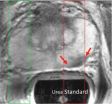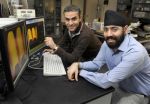(Press-News.org) A fast test to diagnose fatal brain conditions such as mad cow disease in cattle and Creutzfeldt-Jakob disease in humans could be on the horizon, according to a new study from National Institutes of Health scientists. Researchers at NIH's National Institute of Allergy and Infectious Diseases (NIAID) have developed a highly sensitive and rapid new method to detect and measure infectious agents called prions that cause these diseases.
"Although relatively rare in humans and other animals, prion diseases are devastating to those infected and can have huge economic impacts," says Anthony S. Fauci, M.D., director of NIAID. "Scientists have promising concepts for developing therapies for people infected with prion diseases, but treatments only are helpful if it is known who needs them. This detection model could eventually bridge that gap."
Prion diseases are primarily brain-damaging conditions also known as transmissible spongiform encephalopathies. They are difficult to diagnose, untreatable and ultimately fatal. A key physical characteristic of these diseases is dead tissue that leaves sponge-like holes in the brain. Prion diseases include mad cow disease, or bovine spongiform encephalopathy in cattle; scrapie in sheep; Creutzfeldt-Jakob disease in humans; and chronic wasting disease in deer, elk and moose. For more information about NIAID research on prion diseases, visit the NIAID Prion Diseases portal.
Currently available diagnostic tests lack the sensitivity, speed or quantitative capabilities required for many important applications in medicine, agriculture, wildlife biology and research. Because prion infections can be present for decades before disease symptoms appear, a better test might create the possibility for early treatment to stop the spread of disease and prevent death.
Now, a blending of previous test concepts by the NIAID group has led to the development of a new prion detection method, called real time quaking induced conversion assay, or RT-QuIC. This approach is described in a paper now online in the open-access journal PLoS Pathogens. Byron Caughey, Ph.D., led the study at NIAID's Rocky Mountain Laboratories in Hamilton, Mont.
Scientists believe disease-causing prions are abnormal infectious clusters of prion protein molecules. Normally, prion protein molecules are unclustered, harmless and found in every mammal. In a process not fully understood, abnormal infectious clusters develop and can convert normal prion protein molecules into the infectious prion form; these clusters tend to gather in the brain. Ongoing replication allows the disease to spread and damage the brain.
Infectious prions also are found outside the brain, in saliva, blood, breast milk, urine and the nasal and cerebral spinal fluids used in the study. But the concentrations of infectious prions in these bodily fluids are so low that scientists, clinicians and wildlife biologists have not been able to measure them for routine purposes.
The new assay can detect when miniscule amounts of infectious prions initiate the conversion of large amounts of normal prion protein into an abnormal form in test-tube reactions. By comparing the extent to which different samples can be diluted and still initiate conversion, scientists can estimate the relative infectious concentrations in the original samples. In their study, the NIAID scientists used RT-QuIC to detect prion infections in deer known to have chronic wasting disease and sheep known to have scrapie. In scrapie-infected hamsters, they found surprisingly high levels of prions in nasal fluids, pointing to such fluids as possible sources of contagion in various prion diseases.
Along with optimizing their existing applications in the laboratory, Dr. Caughey and his colleagues are teaming up with a number of other laboratories around the world to extend the practical and scientific applications of RT-QuIC. Related testing approaches might also aid the diagnoses of similar neurodegenerative protein diseases, such as Alzheimer's, Huntington's and Parkinson's diseases.
INFORMATION:
NIAID conducts and supports research—at NIH, throughout the United States, and worldwide—to study the causes of infectious and immune-mediated diseases, and to develop better means of preventing, diagnosing and treating these illnesses. News releases, fact sheets and other NIAID-related materials are available on the NIAID Web site at http://www.niaid.nih.gov.
The National Institutes of Health (NIH)—The Nation's Medical Research Agency—includes 27 Institutes and Centers and is a component of the U. S. Department of Health and Human Services. It is primary federal agency for conducting and supporting basic, clinical and translational medical research, and it investigates the causes, treatments and cures for both common and rare diseases. For more information about NIH and its programs, visit http://www.nih.gov.
Reference: J Wilham et al. Rapid end-point quantitation of prion seeding activity with sensitivity comparable to bioassays. PLoS Pathogens 6(12): e1001217. DOI: 10.1371/journal.ppat.1001217 (2010).
END
The research was led by Dr. Matthew Ellinwood, a veterinarian and animal science professor at Iowa State University, in collaboration with Dr. Patricia Dickson at the Harbor-UCLA Medical Center, with colleagues at the Iowa State College of Veterinary Medicine, the University of Tennessee, St. Louis University and the University of Pennsylvania. Their work was published in the AAAS journal Science Translational Medicine.
The research focused on a disorder called mucopolysaccharidosis type I, or MPS I, which is caused by the lack of a key enzyme that breaks down substances ...
November 30, 2010 -- Despite the existence of effective programs for treating alcohol dependencies and disorders, less than a quarter of people who are diagnosed actually seek treatment. In a recent study by Columbia University's Mailman School of Public Health researchers report that people diagnosed with alcoholism at some point in their lifetime were more than 60% less likely to seek treatment if they believed they would be stigmatized once their status is known.
This is the first study to address the underuse of alcohol services specifically with regard to alcohol-related ...
###
Gold, L., et al. (2010). “Aptamer-based multiplexed proteomic technology for biomarker discovery,” PLoS One. Available online at http://dx.plos.org/10.1371/journal.pone.0015004
Ostroff, R. et al. (2010). “Unlocking biomarker discovery: Large scale application of aptamer proteomic technology for early detection of lung cancer.” PLoS One. Available online at http://dx.plos.org/10.1371/journal.pone.0015003
About SomaLogic, Inc.
SomaLogic, Inc., is a privately held biomarker discovery and clinical proteomics company based in Boulder, Colorado. The company's mission ...
A UCSF research collaboration with GE Healthcare has produced the first results in humans of a new technology that promises to rapidly assess the presence and aggressiveness of prostate tumors in real time, by imaging the tumor's metabolism.
This is the first time researchers have used this technology to conduct real-time metabolic imaging in human patients and represents a revolutionary approach to assessing the precise outlines of a tumor, its response to treatment and how quickly it is growing.
Data on the first four patients are being presented today at the Radiology ...
AMES, Iowa – Researchers from Iowa State University and the Ames Laboratory have developed a process capable of producing a thin and uniform light-absorbing layer on textured substrates that improves the efficiency of polymer solar cells by increasing light absorption.
"Our technology efficiently utilizes the light trapping scheme," said Sumit Chaudhary, an Iowa State assistant professor of electrical and computer engineering and an associate of the U.S. Department of Energy's Ames Laboratory. "And so solar cell efficiency improved by 20 percent."
Details of the fabrication ...
(Santa Barbara, Calif.) –– A ballet dancer grasps her partner's hand to connect for a pas de deux. Later that night, in the dark, she reaches for her calf to massage a sore spot. Her brain is using different "maps" to plan for each of these movements, according to a new study at UC Santa Barbara.
In preparing for each of these reaching movements, the same part of the dancer's brain is activated, but it uses a different map to specify the action, according to the research. Planning to hold hands is based on her visual map of space. Her second plan, to reach for her calf, ...
DENVER (December 2, 2010) – Fresh water and reusable energy. Humans are on a constant hunt for a sustainable supply of both. Water purification requires a lot of energy, while utility companies need large amounts of water for energy production. Their goal is to find a low-energy-required treatment technology. Researchers from the University of Colorado Denver College of Engineering and Applied Science may have discovered an answer.
Last year, a study published in Environmental Science & Technology incorporated desalination into microbial fuel cells, a new technology ...
Madrid, 2 december 2010.- Spanish Oncology has established a new standard treatment for Breast Cancer at early stages thanks to the results of the study 9805/Target 0 funded by Spanish Breast Cancer Research Group (GEICAM) and sponsored by Sanofi Aventis.
More than thousand patients and 50 hospitals participated in the study, whose findings are reported in the latest issue of The New England Journal of Medicine. Results indicate that docentaxel during quimotherapy reduces the risk of recurrence by 32% in women with high-risk but node-negative, early stage breast cancer ...
Agricultural – or Neolithic – economics replaced the Mesolithic social model of hunter-gathering in the Near East about 10,000 years ago. One of the most important socioeconomic changes in human history, this socioeconomic shift, known as the Neolithic transition, spread gradually across Europe until it slowed down when more northern latitudes were reached.
Research published today, Friday, 3 December 2010, in New Journal of Physics (co-owned by the Institute of Physics and the German Physical Society), details a physical model, which can potentially explain how the spreading ...
The use of androgen suppression therapy (AST) in prostate cancer for low-risk cases declined following a decrease in physician reimbursement, according to a study published online TK in The Journal of the National Cancer Institute. However, the indicated use of AST for metastatic disease in the palliative setting did not decline in the same period.
The use of AST in prostate cancer increased more than threefold between 1991 and 1999 both for patients with metastatic cancer and those with low-risk disease, but AST treatment in the latter group has not been shown to improve ...

